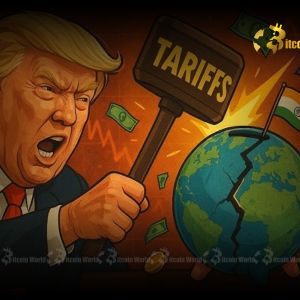Shocking Trump Tariffs: Unveiling New Global Trade Impact
6 min read
The world of international commerce is buzzing once again as former U.S. President Donald Trump, via his Truth Social platform, has made a startling announcement: the imposition of significant Trump tariffs on eight additional countries. This move, revealing letters sent to various global leaders, signals a potentially dramatic shift in the ongoing narrative of US trade relations and could have far-reaching economic implications across the globe. What does this mean for the intricate web of global trade? What Are These New Trump Tariffs and Who’s Affected? In a bold declaration, Donald Trump unveiled details of new tariff impositions, targeting a diverse group of nations. This follows his earlier actions during his presidency and indicates a consistent approach to leveraging trade as a tool for negotiation and influence. The letters, shared publicly, specify varying tariff percentages for each country, reflecting a tailored approach rather than a blanket measure. It’s crucial to understand the specifics of these newly announced duties to grasp their potential impact. Here’s a breakdown of the countries and the announced tariff rates: Country Tariff Rate Brazil 50% Libya 30% Iraq 30% Algeria 30% Sri Lanka 30% Brunei 25% Moldova 25% Philippines 20% This latest batch brings the total number of countries notified of tariff impositions by Trump to 22, showcasing a broad and aggressive stance on international trade policy . These aren’t minor adjustments; the rates, especially the 50% on Brazil, are substantial and designed to create significant pressure on the affected economies. Understanding the Global Trade Impact of Such Moves Whenever a major economy like the United States announces new tariffs, the ripple effects are felt far beyond the immediate borders of the involved nations. The global trade impact of these new Trump tariffs could manifest in several ways, affecting supply chains, commodity prices, and even consumer costs. For instance, a 50% tariff on Brazil could significantly impact agricultural exports or other key commodities, potentially shifting global market dynamics. Similarly, tariffs on nations like Iraq and Libya, often significant oil producers, could have broader energy market implications, though the specific goods targeted by these tariffs would determine the exact nature of the impact. Consider the potential challenges: Supply Chain Disruptions: Companies relying on imports from these countries might need to seek alternative suppliers, leading to increased costs or delays. Retaliatory Measures: Affected countries might respond with their own tariffs on U.S. goods, escalating trade tensions and creating a tit-for-tat scenario. Consumer Price Increases: Tariffs are often passed on to consumers in the form of higher prices for imported goods, reducing purchasing power. Reduced Trade Volumes: Higher costs associated with tariffs can lead to a decrease in overall trade between the U.S. and the affected nations. These actions underscore a persistent belief that tariffs can be a powerful tool to rebalance trade deficits or achieve specific geopolitical objectives, but their broader consequences on global economic stability are always a subject of intense debate. What Are the Economic Implications for Affected Nations and Beyond? The economic implications of these new tariffs extend deeply into the economies of Brazil, the Philippines, Brunei, Moldova, Algeria, Iraq, Libya, and Sri Lanka. For countries like Brazil, a 50% tariff could severely hamper its export competitiveness to the U.S., forcing its industries to find new markets or significantly reduce production. This could lead to job losses, reduced foreign exchange earnings, and a slowdown in economic growth. For nations like Libya and Iraq, where economies might already be fragile due to geopolitical factors, additional trade barriers could exacerbate existing challenges, making recovery or stability even harder to achieve. Conversely, there are also implications for the U.S. economy. While tariffs are intended to protect domestic industries, they can also lead to higher input costs for American manufacturers who rely on imported components. Consumers might also face higher prices for a range of goods. The broader effect on US trade relations is also a critical aspect. These tariffs could strain diplomatic ties, making future cooperation on other international issues more challenging. The delicate balance of global economic interdependence means that unilateral actions often have unintended consequences, creating a complex web of reactions and adjustments across the world. How Does This Shape International Trade Policy Moving Forward? Donald Trump’s continued emphasis on tariffs as a primary instrument of foreign policy raises fundamental questions about the future of international trade policy . His approach challenges the multilateral trade system that has largely governed global commerce since World War II, advocating instead for bilateral agreements and protectionist measures. This strategy, characterized by the new Trump tariffs , prioritizes perceived national interests over global economic integration. It forces other nations to re-evaluate their own trade strategies, potentially leading to a more fragmented global trading environment. Key considerations for the future of trade policy include: Bilateral vs. Multilateral: A shift away from large trade blocs and agreements towards country-specific negotiations, potentially increasing complexity and reducing predictability. Supply Chain Resilience: Nations and corporations may increasingly prioritize diversifying supply chains to reduce reliance on any single country, particularly those prone to tariff imposition. Digital Trade Rules: As physical goods trade becomes more contentious, the focus might shift to establishing rules for digital trade and services, an area where tariffs are less straightforward. Geopolitical Leverage: Tariffs are increasingly being used as a geopolitical tool, intertwining trade policy with national security and diplomatic objectives. This evolving landscape demands that businesses and governments alike develop agile strategies to navigate potential disruptions and capitalize on new opportunities in a world where trade rules are constantly being redefined. Navigating the Complexities of US Trade Relations The announcement of these new Trump tariffs significantly impacts US trade relations with the targeted countries and, by extension, with the broader international community. While the stated goal might be to protect American industries or compel specific policy changes from the affected nations, the reality is that such actions often lead to complex diplomatic challenges. For example, Brazil, a major South American economy, has strong agricultural ties with the U.S., and a 50% tariff could lead to significant friction. Similarly, the Philippines, a long-standing U.S. ally, might view a 20% tariff as a strain on their relationship. This approach to trade relations emphasizes a transactional mindset, where economic leverage is used to achieve specific outcomes. It contrasts sharply with approaches that prioritize long-term partnerships and multilateral cooperation. Businesses operating across borders must now consider the heightened risk of sudden policy shifts and their potential impact on profitability and market access. Understanding the nuances of these relationships, the underlying motivations for such tariff actions, and the potential for diplomatic responses is crucial for anyone involved in international commerce or policy analysis. The ongoing saga of these tariffs will undoubtedly continue to shape the narrative of global economic interdependence. The recent announcement by Donald Trump regarding new tariffs on eight additional countries is a powerful reminder of the ever-present volatility in global trade. These significant Trump tariffs , ranging from 20% to a staggering 50%, are poised to create substantial economic implications for the affected nations and ripple effects across the world. From the potential for supply chain disruptions to shifts in international trade policy and the complexities of US trade relations , the global trade impact of these decisions cannot be understated. As businesses and governments navigate this evolving landscape, adaptability and foresight will be paramount. The future of global commerce remains uncertain, but one thing is clear: trade will continue to be a potent instrument in the geopolitical toolkit, shaping economies and international alliances for years to come. To learn more about the latest global trade trends and their impact on financial markets, explore our articles on key developments shaping international economic policy and institutional adoption.

Source: Bitcoin World



